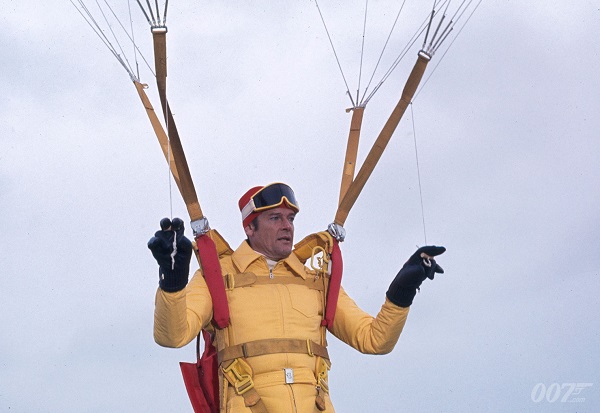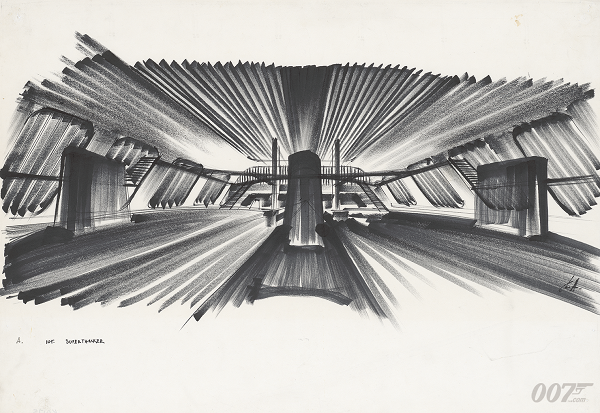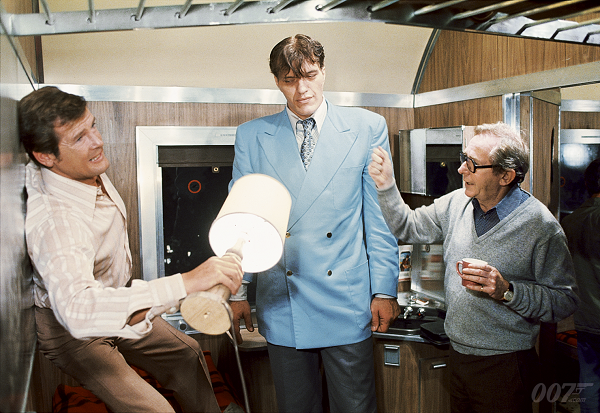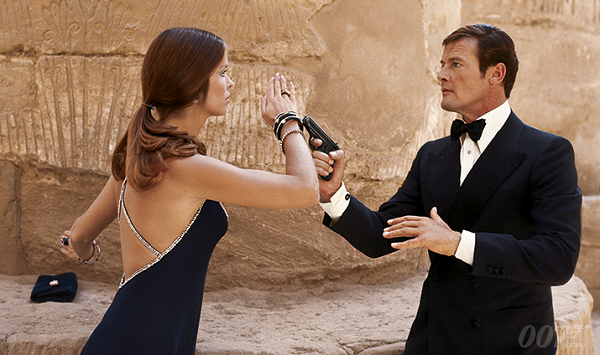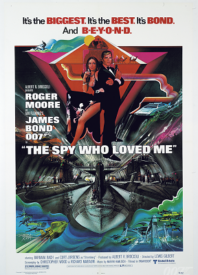
“Can you play any other tune?”
Undeniably Roger Moore’s most fun, and enjoyable outing, The Spy Who Loved Me is the perfect 1970s 007 film. It is emblematic of the entire Moore era. Albert Cubby Broccoli serves as sole producer after Harry Saltzman sold off his shares to United Artists. And where Goldfinger defined Connery’s Bond, The Spy Who Loved Me did the same for Roger Moore. It had the perfect blend of everything the creative team wanted in a Bond film. Fantastic stunts, lots of humour, beautiful women, exotic locations. There are plenty of gadgets. This marks one of the first appearances of the then new sea-doo or wetbike as it was known. And there’s a larger than life world and story.
The tenth official Bond film shares only the title of Ian Fleming’s book. And this is the first film that saw the story being built from the ground up. Cubby tapped Lewis Gilbert, who had previously directed You Only Live Twice to come aboard the production team. And with him came Christopher Wood who took a pass at the script after series Richard Maibaum, injecting more humor. Editor and Unit Director John Glen added important story elements that helped the character arcs play out.
Front and centre in the film is the stunts and gadgets, and Moore seems quite happy to play to them. He served as a charming ringmaster for everything that is going on around him. And the opening ski jump (shot on Canada’s Baffin Island standing in for Austria) has a Union Jack parachute. It perfectly encapsulated what viewers could expect from Moore’s 007 – giant stunts, charm and laughs – audiences would eat it up.
With Christopher Wood’s script casting was underway to fill the world around 007. He pairs Bond up with a Russian agent, XXX, Anya Amasova (Barbara Bach). She’s woman who is practically his equal. 007’s mission is to track down Karl Stromberg (Curt Jurgens). If your screen is big enough, you will notice has webbed hands. He is hijacking Russian, American and UK subs in an effort to start a nuclear war. So he can start humanity anew, under the surface of Earth’s oceans.
There’s a tight dynamic between Amasova and Bond, the chemistry is palatable. And the added tension that he killed her lover adds a nice character arc for the two of them. Rounding out the cast is Bernard Lee as M, Desmond Llewelyn as Q, Lois Maxwell as Moneypenny. The towering Richard Kiel plays Jaws, the stunning Caroline Munro plays Naomi. Walter Gotell (who’d previously appeared as a SPECTRE agent in From Russia With Love) plays General Gogol. And Shane Rimmer makes a final 007 appearance (to date) this time as Carter, commander of the American sub.
Behind the scenes, other familiar names continue to pop up, Micheal G. Wilson is now serving as a special assistant to the producer. Peter Lamont returns as Art Director, Derek Meddings continues effects and miniatures work. That’s something he’s done since Live And Let Die. And there is some fantastic miniature work in this film including Stromberg’s underwater base, Atlantis.
But Ken Adam’s production design is front and centre, and this film could be argued as his finest work. From desert camps to Atlantis, to the stunning submarine hanger. One required the building of a whole new sound stage, christened the 007 stage. Adam’s work is nothing short of stunning throughout this film. It not only brings the James Bond world to life in a way that he hadn’t accomplished before. But it gives it that combination of hyper-reality and fantasy that is the realm the characters exist in. That hanger alone is still iconic. So much so that it garnered an Oscar nomination.
The film also scored nominations for Best Original Score, and Best Original Song. Nobody Does It Better (performed by Carly Simon), is a phrase still tied to the series, and the character. Both the score, and song were overseen by Marvin Hamlisch who was suggested after John Barry proved unavailable. It strikes me as funny that this score was nominated for an Oscar. The Spy Who Loved Me may be one of my favorite Moore Bonds. But this score is one of my least favorites, it is so blatantly 70s.
With no slide whistles in sight, everything is played as theatrical. Laughs come from the dialogue as opposed to things that may detract from the spectacle. From the ski-jump, to the hanger set, to the Q-enhanced Lotus Esprit that fired viewers imaginations. To the towering, threatening Jaws this is Bond and Beyond, spectacle is king!
That being said, there is an in-joke that starts in this film. It gets progressively worse over the next two films. When the Lotus comes out of the water, the assistant director, Victor Tourjanksy, does a double take with his wine. He makes two more appearances, and both of them are groan worthy. They detract from the film experience, through no fault of his own.
Roger Moore kept working on his character. The balance that Moore strove to find is still at work. There are a few singular moments when his 007 seems more violent then he would like to be. That’s considering the actor’s disdain for guns. Specifically, the rooftop scuffle that sees the demise of Sandor (Milton Reid). Clasping to Bond’s tie, 007 gets the info he needs, and then lets Sandor fall to his death. A little cold for Moore’s Bond, but perfectly keeping with the original design of the character. In fact that is something Moore’s Bond will struggle with throughout his run with the character. Yet we know it exists, because, for the first time in Moore’s run, it’s mentioned that he was married. And that he’s sensitive about somethings, specifically that.
In fact, Amasova seems more comfortable with her violent edge than Bond, and looks stunningly beautiful doing it. Especially so in the stunning evening dress designed by Baroness Franka Stael von Holstein. Both she and Bond look unflappable in evening wear. Meanwhile, poor Richard Kiel had to wear a fake set of steel teeth. They caused him such pain that they would have to be removed after about half a minute.
The production had a budget higher than any of the Bond films before it. They shot in a number of locations. From the Pinewood and 007 stages in England, the cast and crew went to Scotland, Canada, Egypt. Egypt is where Cubby cooked a homemade Italian meal for the cast and crew when catering wasn’t up to snuff. They also shot scenes in Italy and Switzerland, while underwater and model shots were done in the Bahamas.
Everything about the film seemed bigger than anything that had been done for the series before. And it looked like it was all there on the screen. Obviously, the advertising for the film would have to reflect that. And a poster design would become as iconic as the film itself was devised. Layered lines and shapes that seem to tastefully scream 70’s, the campaign artwork was deigned by Bob Peak. It remains completely captivating to this day, not looking like any 007 poster before or since. It’s a beautiful piece.
Released on 8 July, 1977 in the UK, The Spy Who Loved Me proved to be box office dynamite. It became one of the top movies of the year, you know, after Star Wars. That year also gave us Close Encounters of the Third Kind and Smokey and the Bandit. And while I didn’t know who James Bond was in 1977, when I would play with my Matchbox cars. But I had made a trade at one point for a white Lotus Esprit that seemed a little too cool….
As the film drew to its conclusion we were promised that James Bond Will Return. Originally, Cubby wanted to move onto For Your Eyes Only. But the return of science fiction to the cinema was profitable. The producers ransacked Fleming’s work to find an appropriate launchpad for a space-themed 007. And Moonraker went into pre-production.
Thanks again to the 007 library of DK Canada. Specifically their Bond By Design: The Art of The James Bond Films. Also thanks to James Bond: 50 Years of Movie Posters, and The James Bond Encyclopedia.
- Release Date: 7/8/1977

